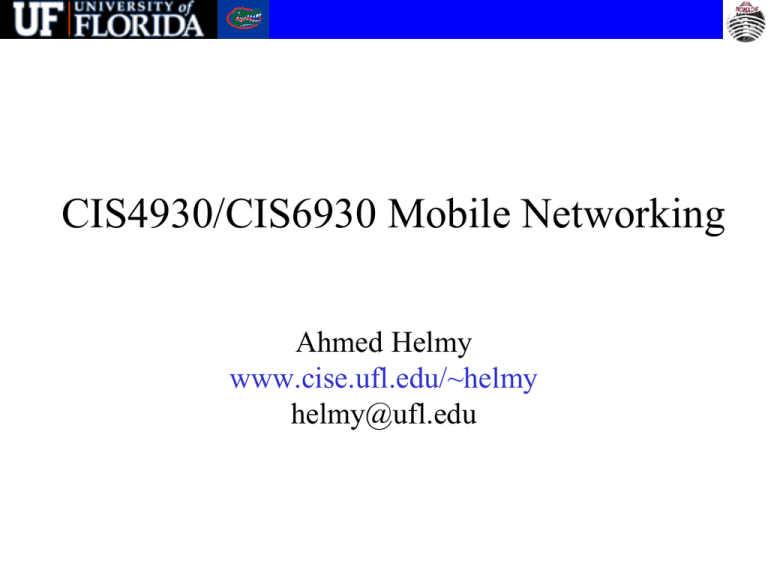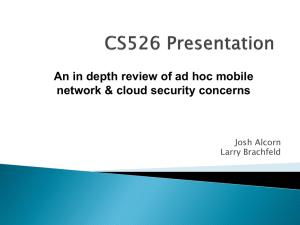Introduction
advertisement

CIS4930/CIS6930 Mobile Networking Ahmed Helmy www.cise.ufl.edu/~helmy helmy@ufl.edu Course Structure • Three main components: – – – – Lecture sessions/class participation Assignments & experiments Major Semester Project (check syllabus for more details) • Web site: www.cise.ufl.edu/~helmy – also check prev. years from CIS6930,EE579/599/499 • ‘Student-centered, seminar-like, hands-on, thought-provoking, advanced research’ course in networking, with networking and wireless lab. Course Components C. Experiments & Assignments (3) -Wireless & mobility tracing (encounter nets) - Friendship and trust measurements (socializer games & apps) -Participatory mobile Attendance, discussion & 4 Reviews : 10% networking scenarios Experiments: 3 x 10%= 30% (project driven!) Project & Presentations: 60% - Topic Presentation: 15% - Project Presentation & Demo: 15% - Written Proposal, Report, Demo: 30% A. Project: 4 milestones (1) Initial proposal (2) Refined proposal (3) Initial report (4) Final report & Demo B. Presentations & discussions: - Topic presentation - Project presentation - Paper readings, reviews & discussions Milestones • • • • • • • • • Forming groups for experiments/projects (1st 2 weeks) Paper reviews: 4 at least [distribute throughout!] Experiments: 3 (one every ~month) Initial Project Proposal (~5th week) Final Project Proposal (~8th week) Initial Project Report (~11th week) Final Project Report/demos (last week of class) Class presentations (sign up) Project presentations (accdg to time, sign up) Course Team Teaching and Lab Assistants: • TA: TBA • Lab/Ph.D.: Udayan, Gautam, Saeed, Jeeyoung, Yibin = Student Groups: - Around 5 groups, each of ‘4-6’ students (experiment groups, project groups) = Sessions: - Lectures - Experiments (TBA) [all wireless/mobile] • Prof. Ahmed Helmy www.ufl.edu/cise/~helmy • (email: helmy@ufl.edu) Course Content • The main emphasis of the course is on measurements, protocols, modeling, analysis & apps for Mobile Ad Hoc Networks (MANets). • The material discussed will be mainly based on carefully selected research papers, book chapters. • Book "Ad Hoc Networking“, C. Perkins. Good collection of research papers [not required]. • The Prof. will present the first few lectures then the students will present their topics. • This course is seminar-like & is student-driven. Intro to Ad Hoc Networks • What is an ad hoc network? – Pure ad hoc – Homogeneous vs. heterogeneous nodes – Wired-wireless heterogeneous networks Example Ad hoc Networks Mobile devices (laptop, PDAs) 8 Vehicular Networks on Highways Hybrid urban ad hoc network (vehicular, pedestrian, hot spots,…) • What are characteristics of ad hoc vs. wired nets? – – – – – – mobility and dynamics higher BER and losses power-constraints infrastructure-less Scale Continuous change of location (addressing?) [wired is physically based] – Connectivity function of relative positions, radio power. May be asymmetric. (spatial vs. relational graph) – other?... • Implications of the Ad hoc environment on protocols? – Many routes may become invalid without ever being used – Protocols need to deal with higher losses and more dynamic environment – Need resource discovery and rendezvous mechanisms (no DNS or AS-based routing hierarchy) – Others… Implications (contd.) • Unicast routing: – table-driven (LS & DV) vs. on-demand (DSR, AODV) – possible multi-path routing for increased robustness • Multicast routing – use of meshes instead of trees • Geographic routing – location-based routing • Security: – No notion of secure gateways or firewalls – Distributed, dynamic, scalable security. Harder! • Others … (loose hierarchy) • Sensor nets vs. ad hoc nets • mobility! • security! • node capabilty and power-constraints! • data-centric nature (vs. human/node centric) • mission/application specific • sensors may be dispensable Networked Mobile Societies Everywhere, Anytime Transportation/Vehicular Networks Sensor Networks Disaster & Emergency alerts Mobile Ad hoc, Sensor and Delay Tolerant Networks Topics • What is included in the "Ad Hoc Networking" book? • Edited chapters by the original authors on: – Unicast routing for ad hoc networks (DSDV, DSR, AODV/MAODV, TORA), – cluster-based routing and hierarchy, – zone routing (ZRP), – efficient link-state/broadcast. Topics (contd.) • What is not included in the book but may be covered in class? – – – – Multicast routing for ad hoc networks Geographic (location-based) routing Mobility modeling Resource discovery. • Other topics (that are not specific to ad hoc networks) include: – Small worlds - peer-to-peer networks – IP mobility - STRESS. General Network Design Framework D e fine D o m a in D esig n & S pec ificat io n M o de ling E va luat io n & T esting S tandard izat io n & Intero perabilit y D ep lo ym e nt & m ea sure m e nt N etw o rk A rchite cture and P roto co l D e ve lo p m e nt M etho do lo g y Network Protocol Architecture Methodology - Define the design space/domain parameters (the target environment) - Design requirements - Scale: #users, #systems, #sessions or calls Reliability (availability) Robustness (proper operation in presence of failure) Performance: throughput, delay, jitter, overhead, etc. - Environment: - Topology (LAN, WAN) and connectivity - Characteristics of media: - wireless (high BER) vs fiber, mobile vs static, etc. - Demand, traffic, applications - Design: determine initial parameters of the network or/and protocol - Specification: state/stipulate clearly, crisply and formally, the rules that govern the operation of the network or protocol - Representation: - Finite state machine (FSM), pseudo code, English! - Observation: - Much of the spec deals with failures/anomalies - Most protocols (esp. network/mac layer) do not have clear robustness performance claims ! - How can we evaluate/test them? - Evaluate the design: - Evaluation criteria - Performance (e.g., overhead, response time, throughput) - Correctness (e.g., absence of deadlocks or duplicates) - Evaluation/modeling methodology - Analysis (mathematical model) [e.g. blocking/cell delay in 1 switch] - Simulation - Hybrid [e.g. # of retransmissions of 100 TCP connections over 1000 node network] Elements of Network Evaluation Studies* • Evaluation metrics: – correctness, performance [need clear definition] • Evaluation Methodology: – – – – Analytical (queuing theory) Network simulation (e.g., VINT/NS) FSM search (e.g., STRESS) Experimentation/measurements • Analysis of results and conclusions * These are extremely important elements to define for the projects Birds-Eye View: Research in the Mobile Networking Lab at UFL Architecture & Protocol Design Robust Geographic Wireless Services (Geo-Routing, Geocast, Rendezvous) Query Resolution in Wireless Networks (ACQUIRE & Contacts) Gradient Routing (RUGGED) Multicast-based Mobility (M&M) Methodology & Tools Test Synthesis (STRESS) Protocol Block Analysis (BRICS) Mobility Modeling (IMPORTANT) Worms, Traceback in Mobile Networks Mobility-Assisted Protocols (MAID) Socially-Aware Networks (AWARE) iTrust, iCast (profile-cast), iTest Behavioral Analysis in Wireless Networks (IMPACT & MobiLib) Emerging Behavior-Aware Services • Tight coupling between users, devices – Devices can infer user preferences, behavior – Capabilities: comm, comp, storage, sensing • New generation of behavior-aware protocols – Behavior: mobility, interest, trust, friendship,… – Apps: interest-cast, participatory sensing, crowd sourcing, mobile social nets, alert systems, … New paradigms of communication?! The TRACE framework x 1 ,1 x1 , n x t ,1 x t ,n MobiLib Trace Characterize, Cluster Represent Analyze Employ (Modeling, Protocol Design) • Possible Projects: Mobility modeling: Suggest a new mobility model and study its effects on a class of ad hoc networking protocols Suggest a new mobility metric and use it to measure and study characteristics of mobility models and ad hoc networking protocols Study effects of different mobility models on various ad hoc networking protocols, including (but not limited to) ad hoc: unicast routing (e.g., DSR, DSDV, AODV, TORA, etc.) multicast routing (e.g., ODMRP, CAMP, MAODV, etc.) geographic routing (e.g., Geocast, GPSR, Grid/GLS, GeoTora) hierarchical routing (e.g., ZRP, LANMAR, cluster-based, etc.) others (Mobility-assisted protocols: EASE, FRESH, MARQ..) Use stress-like approach to synthesize worst-case mobility scenarios – Helpful references: papers on IMPORTANT, BRICS, PATHS, MAID, IMPACT, MILMAN, Stress papers,… EASE/FRESH, Mobility increases... Mobility Modeling and Analysis (contd.) • Use the mobility library of traces (MobiLib) – To analyze and understand characteristics of realistic mobility – Compare realistic (trace-based) mobility to ‘synthetic’ mobility models – Construct new models that are trace-based and extract their parameters from the traces • Contribute to extending the mobility library – By collecting traces of mobility based on surveys, observations, or other methods (with cis6930, ee555 students, etc.) • Are there fundamental characteristics of WLAN traces that do not change with technology (e.g., they apply to future ad hoc networks)? – Study human mobility/behavior for non-wireless traces or nonnetwork traces and compare the characteristics – Suggest another way to investigate such question • References: IMPACT, MAID, other trace pprs, … TVC, Mining Behavioral Profiles Context & Socially-aware Networks, Services & Apps • New services in encounter-based networks: – – – – – – – – Peer-to-peer mobile networks of handhelds Apps to identify friends, profiles, locations, etc. Behavioral pattern recognition & prediction Interest, gender, location & class-based services Activity, role & trust identification Message relaying & routing techniques Network architecture for emergency and education Refs. Profile-cast, gender-based analysis, predication, visualization posters & papers from lab students … • Resource discovery and query resolution: Study and analyze a contact-based approach for resource discovery in large-scale ad hoc networks (use detailed simulations in NS-2) Suggest modifications of ZRP to implement efficient resource discovery Suggest ways in which (partial or approximate) geographic information can improve contact-based architectures Suggest ways in which contact-based archiectures can improve partial or inaccurate geographic routing • Helpful references: papers on CARD, MARQ, TRANSFER, ACQUIRE, Small large-scale wireless networks, ... • Storage-retrieval and rendezvous: Suggest ways in which rendezvous regions (RRs) may be used for storage-retrieval in large-scale ad hoc networks Propose a mixed RRs and contacts architecture for cases of imprecise location information Compare RRs-based architecture to other approaches (e.g., GHT and Grid) qualitatively and quantitatively • Helpful references: papers on large-scale multicast in ad hoc nets, GHT, data-centric, Grid, Rendezvous Regions… • Geographic/location-based routing with partial or imprecise location information Measuring and estimating inaccuracies in location measurement techniques (GPS and GPS-less) [this may easily include experimental lab part] Correctness analysis of geographic/location-based protocols in presence of inaccuracies Performance analysis of geographic/location-based protocols in presence of inaccuracies • Helpful references: papers on Goecast, Grid, GPSR, GeoTora, GPS-less location estimation , … others Small worlds & Social Adhoc Networks • Small worlds in Wireless Networks Show protocols and conditions for achievability and applicability of small worlds in ad hoc networks Suggest new ways in which small worlds may be used in ad hoc networks Use "small worlds of trust" as a basis for a security architecture in ad hoc networks • Helpful references: papers/books on small worlds, six degrees of separation, small large-scale wireless nets, BEBA, TESLA, Ariadne, On nodel encounters, … Network Security for Wireless Networks • Trace-back techniques for Mobile Networks – Develop reasonable models for DoS/DDoS attacks in future ad hoc (potentially mobile) networks – Utilize mobility prediction mechanisms and countermeasures to alleviate such the attacks • Worm/Virus propagation models for wireless networks – Analyze the adequacy of epidemic models for modeling propagation of worms in wireless/mobile networks (e.g., using realistic mobility/encounter models/traces) – Develop defense techniques against such attacks – Examine feasibility of the Vaccine paradigm with counter worms • References: SWAT, ATTENTION, ART, VACCINE, other wireless security papers, … Sapon, Yongjin Themes of Concentration • Mobile Devices as Human Sensors • Human Society as Sensor Network (Participatory Networking) • Behavior-based Networking & mSocial Nets • Examples: – iCast, Profile-cast – iTrust – iTest • Overall: designing, analyzing and implementing the new killer mobile App!! Related websites: • www.cise.ufl.edu/~helmy – – – – Teaching: ee499, ee599-03, cis6930 07, 08, 09 nile.cise.ufl.edu/MobiLib, nile.cise.ufl.edu/important Publications (journals, conferences, book chapters) Projects: • • • • • AWARE project MARS project M&M project - STRESS project VINT project (the network simulator NS/NAM) PIM project • Lab: nile.cise.ufl.edu





